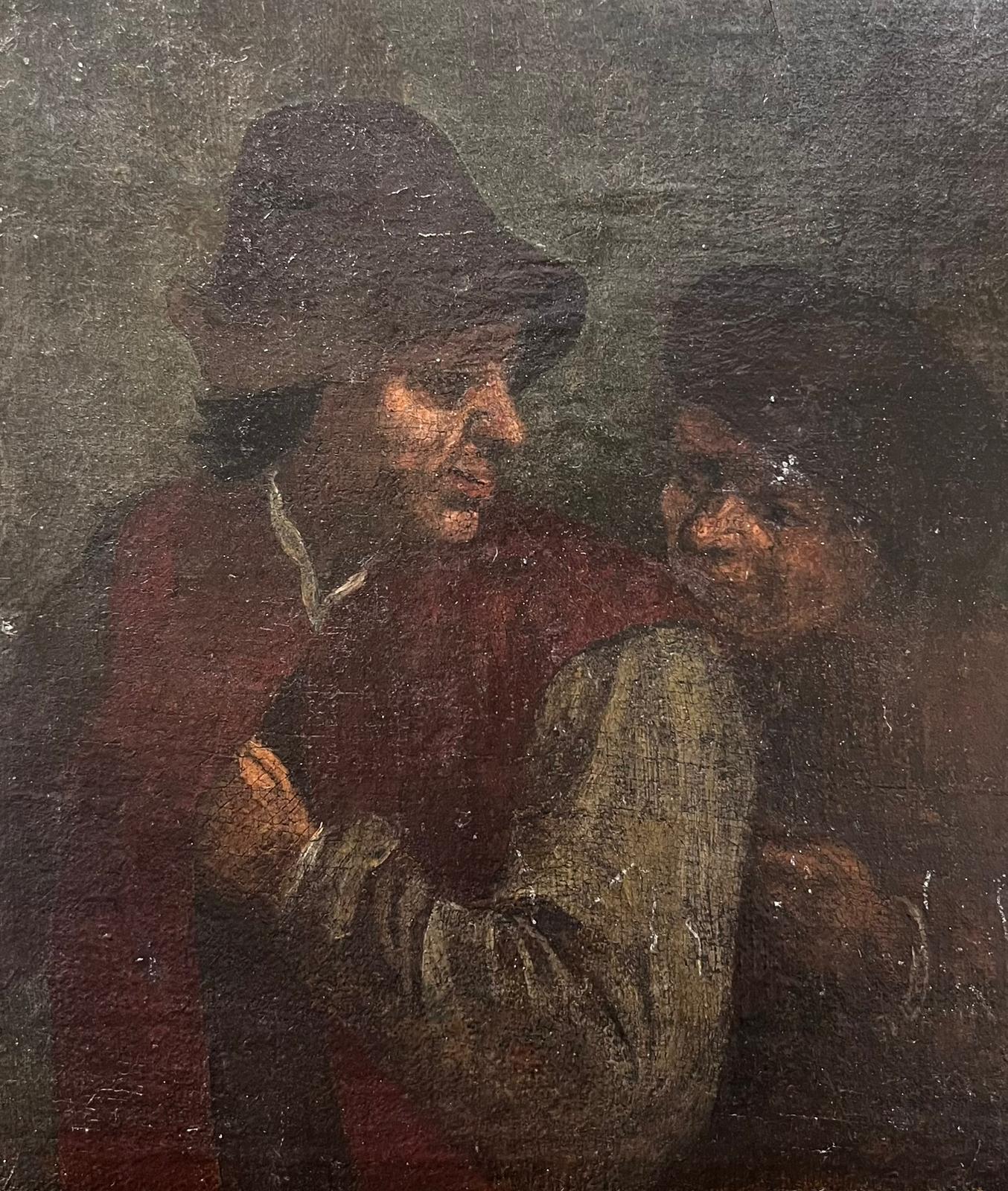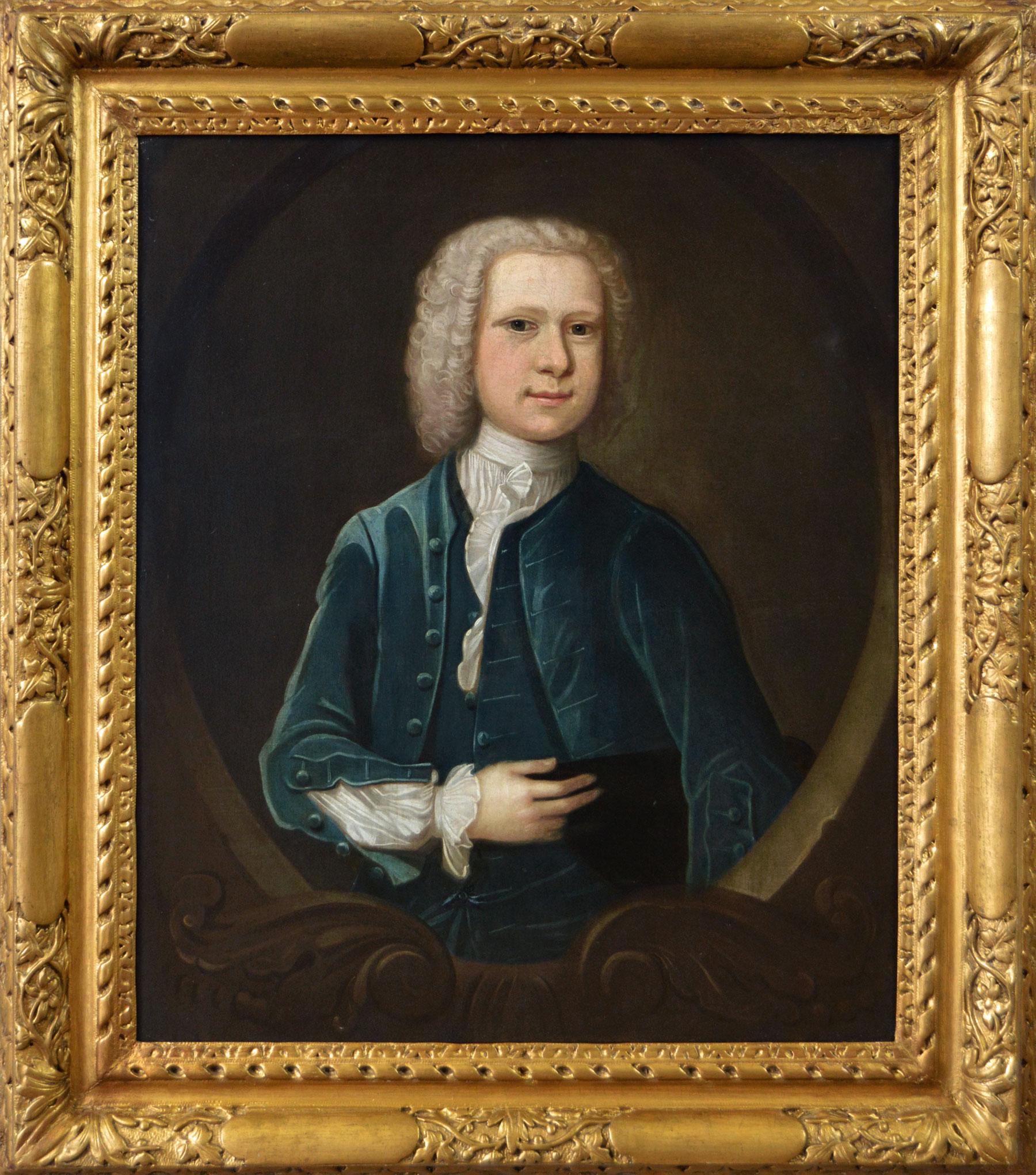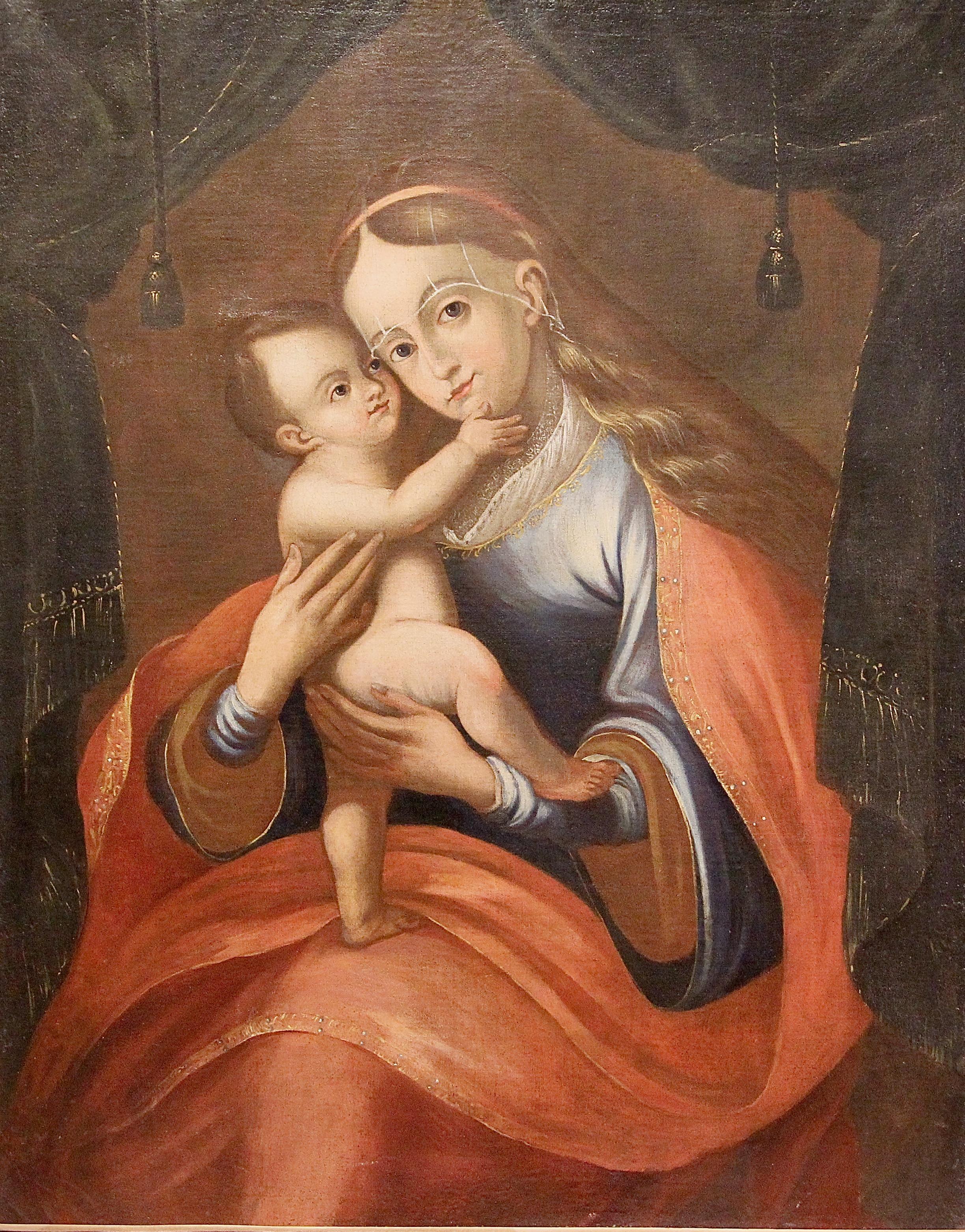Items Similar to 17th century portrait of a lady seated in an interior
Want more images or videos?
Request additional images or videos from the seller
1 of 9
Studio of Peter Lely17th century portrait of a lady seated in an interiorcirca 1665
circa 1665
About the Item
Portrait of a lady, believed to be Henrietta Hyde (née Boyle), Countess of Rochester, (1646-1687) three quarter length, wearing an amber coloured silk gown, with an embroidered blue mantle, seated in an interior.
Oil on canvas in a ‘Lely’ frame with the Hornby Castle inventory number 60 attached on the reverse.
Provenance:
By descent through the Dukes of Leeds, Hornby Castle, Yorkshire;
Christie's, London - The Property of the 10th Duke of Leeds Will Trust, 30th October,
2014, Lot 106.
Private collection Guernsey.
Hornby Castle, Catalogue of Pictures, London, 1898, p. 5, no.60.
Historical and descriptive catalogue of pictures belonging to His Grace The Duke of Leeds, London, 1902, p. 24, no. 60.
Henrietta was born in Wiltshire, to Sir Richard Boyle, 2nd Earl of Cork and Elizabeth Boyle, Countess of Cork. In 1665, she married Laurence Hyde, 1st Earl of Rochester, son of Edward Hyde, 1st Earl of Clarendon and Frances Aylesbury. They had four children. As sister-in-law of Anne Hyde, the Duchess of York she was appointed as governess to her daughter, Princess Anne (the future Queen) between 1677 and 1682.
Like most of the Boyle dynasty, who in the space of two generations had become almost all-powerful in the south of Ireland, Henrietta was strong-minded and acquisitive, and could be ruthless in asserting her rights. During the last two years of her life, when her husband was Chief Minister to his brother-in-law King James II, Henrietta took full advantage of his power to claim every possible privilege. She clashed bitterly with her husband's niece, the future Queen Anne, over who should have the best apartments in Whitehall Palace. Anne, who could herself be a formidable opponent, complained bitterly of her aunt's "peevishness" to her.
Sir Peter Lely (1618-1680) became Principal Painter to King Charles II in 1661 and was commissioned to paint eleven celebrated courtesans and ladies of noble birth of the court in restoration England. A striking portrait of Henrietta Hyde which Lely painted in around 1665 forms part of this collection which initially hung in Whitehall Palace but was later moved to Windsor Castle, hence giving the collection its name of 'The Windsor Beauties'. The collection were recorded as being at Hampton Court Palace by 1835.
- Creator:Studio of Peter Lely (1618 - 1680, Dutch, British)
- Creation Year:circa 1665
- Dimensions:Height: 49.81 in (126.5 cm)Width: 40.16 in (102 cm)
- Medium:
- Movement & Style:
- Period:
- Condition:
- Gallery Location:Bath, GB
- Reference Number:1stDibs: LU95213751532
About the Seller
5.0
Vetted Seller
These experienced sellers undergo a comprehensive evaluation by our team of in-house experts.
Established in 2002
1stDibs seller since 2015
36 sales on 1stDibs
Typical response time: 1 hour
Associations
The British Antique Dealers' AssociationLAPADA - The Association of Arts & Antiques DealersInternational Confederation of Art and Antique Dealers' Associations
- ShippingRetrieving quote...Ships From: Bath, United Kingdom
- Return PolicyA return for this item may be initiated within 3 days of delivery.
More From This SellerView All
- 17th century portrait of a ladyBy Nicolaes MaesLocated in Bath, SomersetPortrait of a lady richly dressed in a purple silk gown with white sleeves, a gold coloured cloak draped across one shoulder, her blonde curls worn up...Category
17th Century Old Masters Portrait Paintings
MaterialsCanvas, Oil
- 18th century English portrait of a lady beside an urn, with a basket of flowersBy Tilly KettleLocated in Bath, SomersetPortrait of a lady wearing a white gown with a red cloak, pearls in her hair and draped over one shoullder, standing beside a classical urn with a basket of flowers, c.1765. The portrait is believed to be a companion portrait of a John (1741-1816) or James (1751-1807) Durno which is housed in an identical frame. The sitter is possibly either the wife of John who was Janes Byres of Stonywood or John and James's sister Elizabeth. (James never married). The Durno family were based around the Aberdeen area of Scotland and John was an advocate in the area and then later a customs official in Jamaica. James was a successful timber merchant, spending time in the Baltic before being made His Majesty's Consul in Memel, Prussia. The portrait is likely to have been painted before Tilly travelled to India in 1768, when John, Jane and Elizabeth would have been in their twenties. We are gtrateful to Mark Beattie for sharing his family knowlege and research on the portrait. Provenance: With W. C. Beattie in the mid 19th century, and by descent through the family Private collection, Kent With thanks to Hugh Belsey who has confirmed this to be the work of Tilly Kettle from photographs. Tilly Kettle (1735-1786) was born in London, the third of six children by Henry Kettle (c.1704-c.1773), a coach painter, and his wife Ann. He attended William Shipley...Category
18th Century Old Masters Portrait Paintings
MaterialsCanvas, Oil
- 17th century portrait of a ladyBy Nicolaes MaesLocated in Bath, SomersetPortrait of a lady by Dutch Golden Age painter Nicolaes Maes (1634-1693). Half-length, within a feigned oval, the lady wears a pearl necklace and earrings, an ivory silk gown adorned...Category
17th Century Old Masters Portrait Paintings
MaterialsCanvas, Oil
- 18th century painting of the Dalbiac family in the gardens of a country houseBy Charles PhilipsLocated in Bath, SomersetThe painting depicts James (Jacques) Dalbiac, his wife Louise (ne de la Porte) and their five children, James, Charles, Louise, Marianne and Martha in the ornamental gardens of a grand country estate. The extensive gardens extend into the distance with gardeners working in the background and figures strolling through the avenues of trees. A peacock and peahen can be seen on the wall to the left and a potted orange tree to the right. Louise Dalbiac holds an orange taken from the orange tree, aluding to the family's faith and their loyalty to the protestant King William of Orange and their adopted country. The Dalbiacs were wealthy London silk and velvet merchants of French Huguenot origin who had fled France at the end of the 17th century to escape persecution for their protestant faith. England offered safe refuge and their skills and industriousness allowed them to establish one of the most successful businesses in London's Spitalfields which became a new centre of the silk trade, effectively leading to the collapse of the once dominant French silk industry. Both sons, James and Charles followed their father and Uncle into the family business, successfully growing the family's fortune and each going on to own their own country estates. A conversation piece is a genre of painting used to describe group portraits of families and friends, often depicted with their servants and family pets and set within an elegantly furnished interior or the garden of a grand country house. They were a celebration of the intimacy of family relations as well as a sign of status, property and the power of succession. The informality of conversation pieces grew popular in 18th century England, allowing the sitters to present themselves in a more relaxed pose, perhaps engaged in intellectual conversation or showing their talents or interests. In this present portrait, the Dalbiacs are shown richly dressed and and at leisure in a grand country house setting, conveying their success and cultural and social aspirations. Charles Philips (c.1703–1747) was an English artist known for painting a number of portraits and conversation pieces for noble and Royal patrons in the mid-eighteenth century. He was the son of portrait painter Richard Philips...Category
Early 18th Century Old Masters Portrait Paintings
MaterialsCanvas, Oil
- English 17th century portrait of James Thynne as a young boy by a fountainBy Johann KerseboomLocated in Bath, SomersetPortrait of the Hon. James Thynne (c. 1680-1704), full-length, in the gardens of Longleat House, seated beside a fountain, holding a shell beneath water spouting from a horn blown by a cherub on a dolphin. A glimpse of part of Longleat House can be seen upper left. Oil on canvas in a period giltwood frame, decorated with leaves and acorns. C. 1682. Dimensions: 145 x 123cm (57 x 48in) in frame Provenance: Ex Longleat House, Wiltshire Private collection, Bath James Thynne was the youngest son of Thomas Thynne, 1st Viscount Weymouth and Frances Finch of Longleat House, Wiltshire. He died in his youth and his Aunt, Anne Kingsmill Finch, Countess of Winchilsea (1661-1720), wrote a moving poem on his death. He was buried in the family vault at Longbridge Deverill, Wiltshire. A mezzotint of this painting by William Faithorne the Younger is held in the Royal Collection. Johann Kerseboom (d.1708) was the nephew of Frederick Kerseboom and first worked in Germany before coming to England in the 1680's where his sitters included the 'Electress Sophia Dorothea' (known from a mezzotint by William Faithorne). His early works were influenced by William Wissing...Category
17th Century Old Masters Portrait Paintings
MaterialsOil, Canvas
- Attributed to John Riley, 17th century English portrait of a girl on a terraceBy John RileyLocated in Bath, SomersetPortrait of a young girl, full-length, wearing a blue silk gown, standing on a terrace beside a classical urn holding a branch with blossom. Attributed to John Riley...Category
17th Century Old Masters Portrait Paintings
MaterialsOil, Canvas
You May Also Like
- Fine 17th Century Dutch Old Master Oil Painting Two Topers in Deep ConversationLocated in Cirencester, GloucestershireTopers in Deep Conversation Dutch School, mid 17th entury circle of David Teniers (Dutch 1610-1690) oil on canvas canvas: 8 x 7 inches provenance: private collection, France conditio...Category
Mid-17th Century Old Masters Figurative Paintings
MaterialsCanvas, Oil
- Fine Italian Old Master Oil Painting Angel & Saints Appearing to FiguresLocated in Cirencester, GloucestershireArtist/ School: Italian Old Master, 18th century Title: Angel and Saints appearing to figures, one dressed in a white ruff collar. Medium: oil on canvas...Category
Early 18th Century Old Masters Figurative Paintings
MaterialsOil, Canvas
- 17th Century Italian Old Master Oil Painting Moses Striking Water from the RockBy Pier (Pietro) DandiniLocated in Cirencester, GloucestershireMoses Striking Water from the Rock; Circle of Pietro Dandini, Italian 1646-1712 Italian School, late 17th century oil on canvas, framed framed: 3...Category
Early 18th Century Old Masters Portrait Paintings
MaterialsOil, Canvas
- 18th Century portrait oil painting of a gentlemanLocated in Moreton-In-Marsh, GloucestershireFollower of Enoch Seeman the Younger German, (1694-1744) Portrait of Gilbert Sympkin Oil on canvas Image size: 29.25 inches x 24.5 inches Size including frame: 38 inches x 33.25 inches A fine three quarter length portrait of a gentleman traditionally identified as Gilbert Simpkin (Sympkin), follower of Enoch Seeman the younger, C1720. The portrait is set in a feigned sculptured oval cartouche, a device used to give a sense of depth. The sitter is depicted wearing a fashionable blue jacket and matching waistcoat with a white chemise and lace jabot. He wears a powdered wig in the fashionable style of the day and is posed holding his hat under his left arm with the fingers of his right hand stretched out. At court, long fingers signified wealth, culture and intelligence. The painting has clearly been executed by an artist of great ability who has been influenced by Enoch Seeman the younger. Gilbert Simpkin (Sympkin) was born in London on 24 August 1683, the son of John Simpkin and Susannah Butler. His grandfather was also called Gilbert Simpkin. He entered Oxford University in 1700 where he studied at St John’s College. In 1702, he became a student of Middle Temple, which at the time was one of the world’s most important centres of legal education. He later settled in Plymouth and then Bristol. He died in Bristol on 15 May, 1744 and was buried at Bristol Cathedral. He remained unmarried and the portrait may well have been commissioned to commemorate when he was first Called to the Bar or perhaps had established his own practice. Enoch Seeman or Seemann the younger was born in Danzig, Germany now Gdansk, Poland in 1694. His father was Enoch Seeman Senior, an artist of Flemish origin and his brothers Isaac, Noah and Abraham also became artists. He came to London with his father and brothers around 1704 and established himself as a portrait artist. From 1717 he became painter to the Royal court painting...Category
18th Century Old Masters Portrait Paintings
MaterialsCanvas, Oil
- 18th Century, Antique Oil Painting, Old Master. Portrait of Mother with child.Located in Berlin, DE18th century, antique painting, oil on canvas, old master. Mother with child. Relined canvas. Stretcher frame also renewed. Artist unknown.Category
18th Century Old Masters Figurative Paintings
MaterialsCanvas, Oil
- 17th Century, Old Master, "King Basileus Alexander of Macedon Magnus, the Great"Located in Berlin, DEVery decorative, 17th century, old master painting, oil on canvas, King Alexander Magnus, the great. Illustration of two children, putti, with wreaths of flowers on a board (or maus...Category
17th Century Old Masters Figurative Paintings
MaterialsCanvas, Oil





